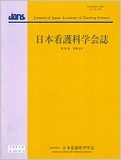Japanese
English
- 販売していません
- Abstract 文献概要
- 参考文献 Reference
要旨
目的:クリティカルケア領域における浅い鎮静深度で管理されている人工呼吸器装着患者に対する看護実践の特徴を明らかにする.
方法:急性・重症患者看護専門看護師および集中ケア認定看護師を対象に半構造化面接を実施し,質的帰納的に分析した.
結果:対象者13名から【患者の複数の情報を統合し苦痛を読み取り積極的に緩和を試みる】【患者に医療機器・装着物を繰り返し見せたり触らせたりすることでその存在を示す】【患者に急激な身体状況の変化や今後の見通しについて繰り返し説明する】【患者の自発的な行動を尊重すると同時にその危険度を見極める】【患者の同意を得ながらケアやリハビリに取り組めるよう導く】【患者−家族間を仲介し相互の距離を調整する】の6つの看護実践が明らかとなった.
結論:看護師は浅い鎮静において,患者の力を引き出しながら,患者と協働して看護実践を組み立てていく必要があることが示唆された.
Purpose: To identify the characteristics of nursing practice for mechanically ventilated and lightly sedated patients in critical care.
Methods: Semi-structured interviews were conducted with Critical Care Nurse Specialists and Certified Intensive Care Nurses. The data derived from the interviews were qualitatively analyzed by using an inductive approach.
Results: Responses were obtained from 13 subjects, which revealed the following six characteristics related to nursing practice in critical care: “integrating multiple data of individual patients and inferring their pain, and actively trying to ease the pain,” “making sure that patients are aware of the medical devices and wearable objects that are being used on them by letting them see or touch devices and objects repeatedly,” “repeatedly explaining to patients that there has been a sudden change in their condition and informing them of their prognosis,” “respecting patients' voluntary behavior and at the same time determining if it could be a danger to the patients,” “leading patients to work on care and rehabilitation while obtaining the patients' consent,” and “mediating between patients and their family and adjusting their distance.”
Conclusions: The present study suggests that nurses should try to empower patients under light sedation to provide better-structured and well-informed nursing care through collaboration with patients.
Copyright © 2019, Japan Academy of Nursing Science. All rights reserved.


